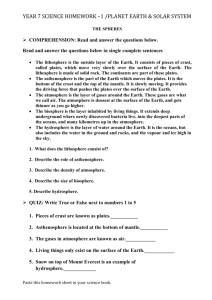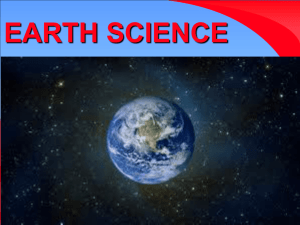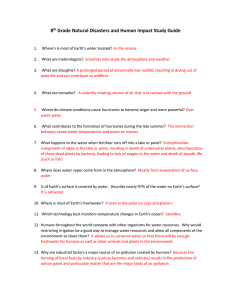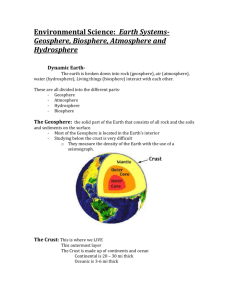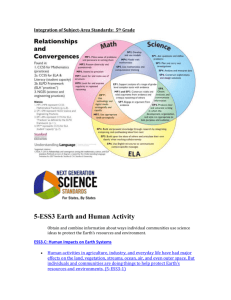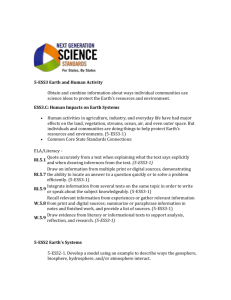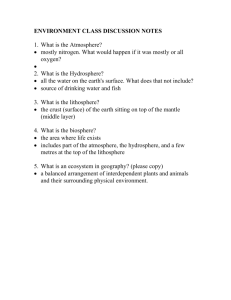ES 3 The Dynamic Earth
advertisement
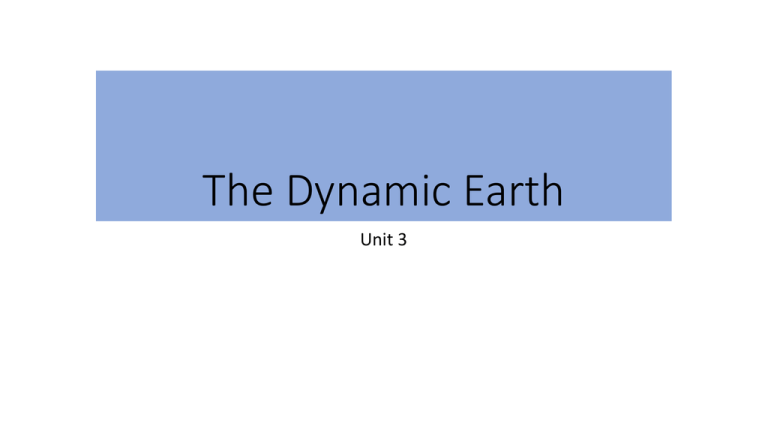
The Dynamic Earth Unit 3 3-1 The Earth as a System Earth consists of rock, air, water, and living things; all interact with each other. • Earth system into four parts: • -The Geosphere (rock) • -The Atmosphere (air) -The Hydrosphere (water) • -The Biosphere (living things) The Earth as a System The Geosphere • -Mostly solid, rocky part of the Earth. • -Extends from the core to the crust. • -Atmosphere is a mixture of gases that makes up the air • we breathe. The Hydrosphere • -Made up of all the water on or near the Earth’s surface. • -Oceans cover nearly threequarters of the globe. • -Water is also found in the atmosphere, on land, and in the soil. The Biosphere • -Part of the Earth where life exists. • -Thin layer that extends from about 9 km above the Earth’s surface to the bottom of the ocean. -Made up of parts of the geosphere, atmosphere, and hydrosphere Discovering Earth’s Interior • -Seismic waves are used to learn about Earth’s interior. • -Seismic waves travel through Earth’s interior during an earthquake. • -The speed and direction of seismic waves reveal the different layers of the Earth. The Composition of the Earth Earth is divided into three layers: •The crust •The mantle •The core • -layers are progressively denser • toward the center of the Earth. The Crust • -Thin, solid outermost layer of the Earth. • -Makes up less than 1 percent of the planet’s mass. • -Is 5 km to 8 km thick beneath the oceans and 2070 km thick beneath the continents. The Mantle • -Layer of molten rock between the Earth’s crust and core. • -Makes up 64 percent of the mass of the Earth. The Core -Central part of the Earth below the mantle. -composed of nickel and iron. -estimated temperature: btw 4,000°C to 5,000°C - is solid because of enormous pressure. Earth’s Structure Earth can be divided into five layers based on physical properties: -Lithosphere: solid, outer layer of the crust and rigid upper part of the mantle. -is divided into huge pieces called tectonic plates. Earth’s Structure (cont’d) -Asthenosphere: solid, plastic layer of the mantle beneath the lithosphere. -made of slowly flowing mantle rock, which allows tectonic plates to move on top of it. -Mesosphere: lower part of the mantle Plate Tectonics • Divisions of lithosphere. • Glide across the asthenosphere. • Major plates: Pacific, North America, South America, Africa, Eurasian and Antarctic. Plate Boundaries • Site of major geologic activity. • Plates may collide, pull apart, or “slip” past one another. • Forces may result in earthquakes, volcanoes or mountain building. Earthquakes • Faults are breaks in the crust. • Slippage along faults vibrate crust create earthquakes. • Richter scale quantifies magnitude earthquake energy. -smallest magnitude: 2.0 -largest magnitude: 9.5 • Most active fault in N.A.: San Andreas along California. Where do Earthquakes Occur? FYI: Earthquake Hazard • Scientists cannot predicts when earthquakes will take place. However, they can help provide information about where earthquakes are likely to occur helping people prepare. • An area’s earthquake-hazard level is determined by past and present seismic activity. • Earthquake-resistant buildings, built in high risk areas, are slightly flexible so that they can sway with the ground motion preventing them from collapsing. Plate Tectonics and Mountain Building • -Colliding plates form mountain ranges • Ex. The Himalaya Mountains Volcanoes Mountain built from magma. Can occur on land or in the sea. Often located near tectonic plate boundaries- plates are either colliding or separating from one another. Majority of active volcanoes on land are located along tectonic plate surrounding the Pacific Ocean. Volcanoes: The Ring of Fire Local Effects of Volcanic Eruptions • -Clouds of ash, dust, and gases can flow down the slope of a volcano at speeds of up to 200 km/hr. • -Can burn everything in its path. • -Volcanic ash mixed with water can produce mudflows. • -Falling ash can cause buildings to collapse under its weight, bury crops, damage the engines of vehicles, and cause breathing difficulties. Global Effects of Volcanic Eruptions • -Major eruptions can change Earth’s climate for several years. • -Clouds of volcanic ash and sulfur rich gases may reduce the amount of sunlight that reaches the Earth’s surface. • -Reduction in sunlight can cause a drop in the average global surface temperature. Erosion • -Process in Earth’s surface is loosened, dissolved, or worn away and transported by wind, water, ice or gravity. • -Wears down rocks and makes them smoother with time (reason why older mountains are smoother than younger ones). Water Erosion • -Rivers and oceans can produce major changes on Earth’s surface. • -Waves from ocean storms can erode coastlines. • -Rivers can carve deep gorges into the landscape. Wind Erosion • -At beaches and in deserts, wind can blow soil away quickly. • -Soft rocks, such as sandstone, erode more easily than hard rocks, such as granite do. Sect 2: The Atmosphere • Mixture of gases: Nitrogen (N₂)- 78% Oxygen (O₂)- 21% CO₂, H₂O, argon- 1% • Insulates the earth from heat and cold. • Held in place by gravity Layers of the Atmosphere • Troposphere: closest to surface, site of weather. • Stratosphere: above the troposphere, site of ozone -ozone (O₃) protects against harmful UV radiation from sun. • Mesosphere: coldest layer. • Thermosphere: lowest layer is ionosphere- site of aurora borealis Energy in The Atmosphere Energy from the sun is transferred as heat by: 1. Radiation: across space. 2. Conduction: warm to cold. 3. Convection: air molecules -hot air rises, cold air sinks. The Greenhouse Effect • Process in which gases trap heat near the Earth’s surface. -sunlight heats the surface the day. -some of the heat escapes back into space. -remainder of heat is trapped by greenhouse gases (methane, CO₂, nitrous oxide, water vapor). Sect 3: The Hydrosphere and Biosphere • Hydrosphere: includes all water on or near Earth’s surface… -oceans, lakes, icecaps, soil, clouds. The Water Cycle • Continuous movement of water between air and land. • 3 major processes: -evaporation: liquid to vapor. -condensation: vapor to droplets, forms clouds. -precipitation: rain, snow, sleet, hail. Oceans • Single, interconnected body of water. • Covers 70% of planet. • Largest ocean: Pacific -deepest point: Challenger Deep -currents move clockwise north of equator; counterclockwise south of the equator. Oceans (cont’d) • 2nd largest ocean: Atlantic • Smallest ocean: Arctic -unique feature: pack ice covers much of ocean’s surface. Ocean Water • Contains dissolved salts, most of which is sodium chloride. • Salinity: concentration of all salts in water. -lower where fresh water flows into ocean. -higher where water evaporates quickly. Ocean Zones • Surface zone: warm top layer; currents mix warm and cool water. • Thermocline: boundary between warm and cold water; temperature drops faster with depth than other zones. • Deep zone: bottom zone with coldest temperatures. Ocean Currents • Surface: wind driven, result from global winds. -may be warm or cold. -can flow for hundreds of km.s ex. Gulfstream -influence climate of land. • Deep: flow slowly on ocean floor. -cold polar water sinks, moves toward the equator. Global Temperature Regulator • Ocean waters absorb, store energy from sunlight. • Water absorbs, releases heat more slowly than land, results in slower atmospheric temperature changes. • Temperature regulation prevents extremes on Earth. Fresh Water • Contains insignificant amounts of salts. • ≈ 3% of all water. • Most is locked up in icecaps, glaciers • Liquid form is found in lakes, rivers, wetlands, the soil, atmosphere. River Systems • Network of streams that drains an area of land. • Contains all of the land drained by a river, including the main river and its tributaries: small streams that empty into a river. • Mississippi River system covers ≈ 40% of the contiguous U.S. Groundwater • Area underground that collects rain, melting snow. • Less than 1% of all water. • Fulfills the human need for fresh drinking water, supplies agricultural and industrial needs. • Aquifers: rock layer that stores and allows the for the flow of groundwater. -recharge zone: surface of land where water enters aquifer. The Biosphere • Narrow layer of planet where life is found (includes geosphere, lower atmosphere, hydrosphere). • Closest to surface because of ample sunlight there. • Dependent on gravity, water, nutrients. Energy Flow Through the Biosphere • Begins as sunlight trapped by plants in photosynthesis. • Dead organisms are broken down, its energy and nutrients are passed on to others. • Recycling of nutrients and energy flow make life possible. Mount St. Helens, Washington State Mount St. Helens, Washington State
